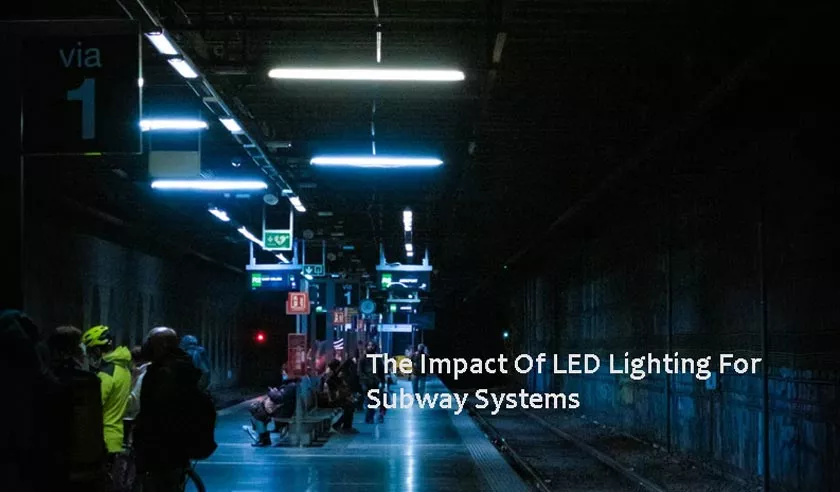The world of urban transportation is evolving, and subway systems play a vital role in keeping Hong Kong connected and moving. As the MTR runs underground for more than fifteen hours a day, it is essential that underground stations, train carriages, and concourses are well-lit to keep staff and passengers safe.
With the advent of LED technology, this illumination has been made much easier, more energy-efficient, and cost-effective.

The Impact of LED Lighting For Subway Systems – Enhancing Safety, Efficiency, And Sustainability
In this article, we will look at the impact and advantages of using LED lighting for subway systems. Before that, we shall review some of the key areas LED lighting plays a role, from illuminating train carriages and tunnels to providing well-lit signage.
Applications of LED lighting in subway stations
When we talk about LED lighting systems, we are talking about a series of components. These LED system components range from COB LEDs, drivers, lenses and reflectors, strip lights, to the array mounts and cables that help them stay in place.
They come together in different combinations for a series of applications in subway stations. Let’s explore some of them.
Platform lighting
One of the most common applications of LED lighting in subway stations is on platforms. Platform lighting can consist of ceiling lights, wall lights, and fixtures placed strategically along platform edges.
The glare-free quality of LED lighting has the potential to enhance safety and reduce the risk of accidents, while the illuminated platform can provide a comfortable and visually appealing ambiance.
Tunnel lighting
LED lighting is used to illuminate subway tunnels, which is essential for train operators and maintenance personnel to drive trains and to conduct repairs. In tunnels, LED lighting may be recessed in the walls or ceiling, and they are usually placed uniformly through the length of the tunnel.
Signage and wayfinding
In every station, there are backlist signs and systems that allow passengers to find their way around. There is also lighting in ticketing areas, in ticketing machines and entrances and exits. Additionally, dynamic LED displays can provide information on when trains are arriving and delays.
Escalator and staircase lighting
Of course, there must be plenty of lighting along paths within subway stations, and LED lighting can be integrated into escalators, staircases, and lifts.
This ensures the safety of passengers, and most commonly, LED light strips line the handrails and the edges of steps to provide clear visibility.
Emergency lighting
During power outages, LED lighting can also provide backup illumination. These reserve LED lights may be used in emergency lighting systems, and they are essential to ensure evacuation routes and exits remain visible to staff and passengers.
Advertisement boards and signage
Plenty of advertisement boards and signage are backlit by LED lights, as many commuters are aware. These advertisements are often lit and shown on display for hours on end each day along the dark tunnels and on the walls of escalators.
Exterior lighting
Finally, a common LED lighting application is on the exterior of subway stations, covering pathways that lead to the station during the night.
Impact and benefits of LED lighting for subway systems
There are three main benefits of using LED lighting for subway systems. They concern the experience of staff and passengers, aesthetics and design of the stations, and finally, the higher cost savings made possible with LED technology.
Improving staff and passenger experience
One of the most significant benefits of using LED lighting is to illuminate subway stations, carriages, tunnels, and every space in between.
Being in a brightly lit station not only improves passenger safety, but as LED lighting does not pierce the eye, it also ensures that passengers are not in discomfort when they use the subway system.
This improves passenger experience greatly, and it also allows subway staff to find more comfort in working in the stations and trains.
Located metres underground, subway stations require a lot of illumination, as artificial lighting is their only source of light. The low heat emission of LED lights also allows the stations to remain at lower temperatures, which reduces the need to turn up air conditioning systems. This makes subway train carriages and stations more comfortable for both staff and passengers.
Flexibility in lighting design
Aside from providing plenty of illumination, the small size of LED lighting components also makes it easy for subway stations to utilise them in every space required.
LED lights require minimal space and can be integrated easily into platforms, ceilings, walls, and even handrails and signage, which are vital. They can also provide plenty of flexibility in lighting design as they can be mounted in different locations.
Whether recessed in walls and ceilings or installed on poles and columns, LED lights can be placed strategically for aesthetics and way finding.
Energy efficiency and cost savings
Finally, the use of LED lighting in subway stations provides significant enhancements in energy efficiency, which in turn lead to cost savings for the government and train company.
LED lighting has low energy consumption compared to traditional lighting sources, and this reduces the amount of energy consumed, in turn lowering the amount of electricity used.
On top of being energy efficient, LED lights are also incredibly durable and have a long shelf and operational lifespan. They can operate for tens of thousands of hours before needing to be replaced, which decreases the frequency of maintenance visits and replacement of components.
Though this may not seem significant, this can lead to substantial cost savings for train companies and the government in the long run.
Final words
The applications of LED lighting in subway stations are diverse and versatile, and LED lights have a great impact on providing visibility for both staff and passengers to ensure their well-being and safety. LED components are small, durable, and have long operational lives, making them a superior option compared to traditional lighting.
By leveraging these benefits, subway stations can create well-lit and visually appealing environments that can ultimately improve the passenger experience.
